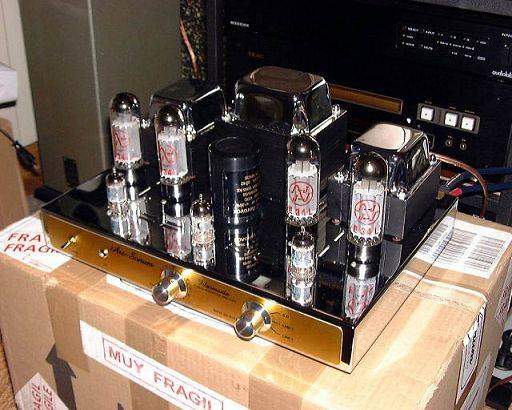
| [ Ars Sonum Filarmonia amplifier] |

With this article I achieve my objective of testing and writing my personal impressions about the three best known hand made tube amplifiers manufactured in Spain: the George 50/50, the Tecno Line MJ 60 and, finally, the Ars Sonum Filarmonia. The main objective when I began to plan these auditions was to test these amplifiers because I believe that they're excellent examples of the build quality of spanish manufacturers and also because with them it is possible to have a tube amplifier without asking your bank for a second mortgage. Other reasons to test these amps were: they're great to begin to play with tube amplification equipment (if you're interested in this matter you can read my article "I want a tube amplifier") because they have enough power to be used with modern loudspeakers; they have quality and reliability; they have a modest price and finally because of the users feedback about them: all the people who already owns them are very happy with the results they get. In addition to that, as you know, I have a kind of obssession with hand made tube amplifiers and this was an excellent oppotunity to share it with you. If you find these articles useful I will be happy.
As I said at the beginning, this article is the third and last test (uhmm?) of this kind of amplifiers. Now, I bring to you the Ars Sonum Filarmonia kindly provided by Ricardo Hernández. Ricardo Hernández is a veteran in the spanish tube audio desing world and, in general, in the high fidelity arena. His father was in the audio bussines many years ago and he's following his footsteps.Ars Sonum is the name that Ricardo has chosen for his products but before he distributed some of his designs under the Yadeck Audio name. Ricardo puts all his passion and knowledge about hi-fi in this amplifier and I must admit that he does it rigth.
The Ars Sonum Filarmonia is an stereophonic tube amplifier that delivers 30 watts RMS of power output. It uses four JJ E34L pentodes as power tubes, a Philips JAN 5814A double triode (improved version of the ubiquous ECC82) as phase inverter/driver and a Tesla 6922 (E88CC) as input tube. The amp uses a Push-Pull configuration with a special grid-screen regulation circuit developed by Ars Sonum (instead of the most common ultralinear) and automatic polarization. This configuration allows to use a very low amount of global negative feedback in the amplifier's circuit and so, it is possible to have a very low distortion level, a greater phase coherence, more stability in all the frequency range and lower levels of TIM. These 30 watts are all almost in class A, but when necessary (musical peaks) the amplifier changes to class B, returning into class A rapidly. The manufacturer recommends speakers with a sensitivity of 89dB/1w/1m


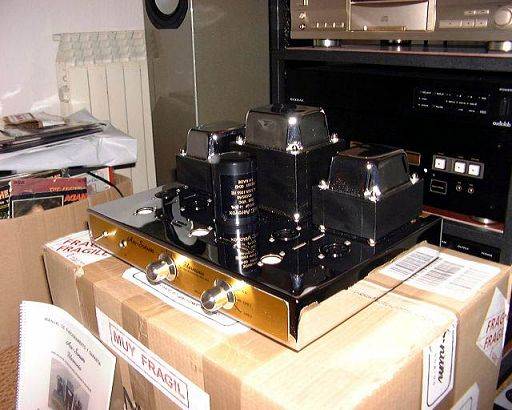
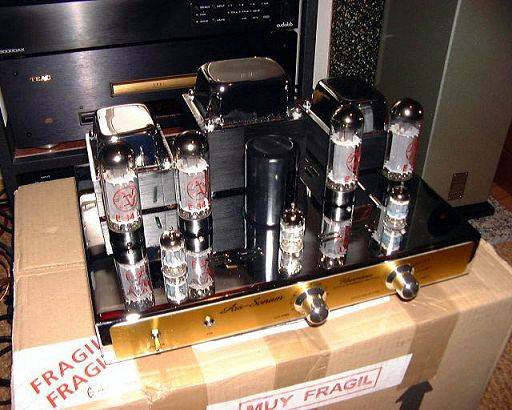
The amplifier comes very well packaged with all the tubes in small boxes protected with bubble plastic. There's a user manual and a demo CD with good quality musical tracks. After unpacking the amp we can see how it looks. The amplifier is mounted on a chassis that is triple-chromed and polished and that looks excellent. In the back we can see, from left to rigth, a group of gold-platted RCA connectors where we can connect three line inputs and a tape output. Close to the RCAs there're the speaker binding posts and at the opposite side of the back panel there's the power cord connector. In the front panel we can see a gold plated plate with all the lettering written on it (volume, source selector, on/off ) and all the controls that include from left to rigth the on/off switch, an on/off led, the volume potentiometer and the source selector. The knobs are made of polished machined aluminium blocks. The touch is soft and they look great. In general terms the Filarmonia is similar to other hand-made amplifiers and it's clear to the observer eyes the care used when building the amp.
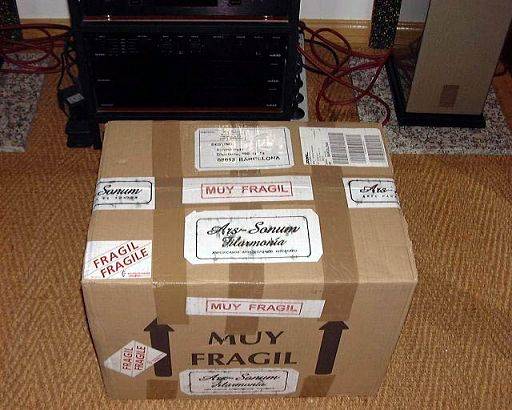

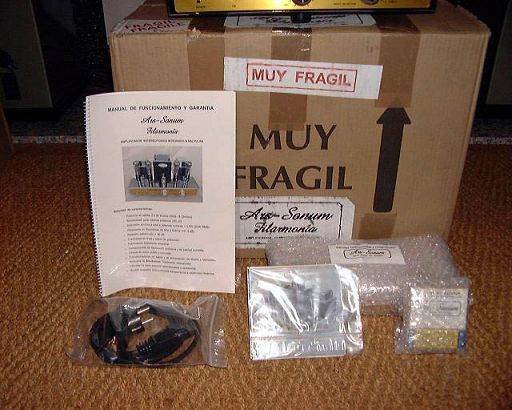
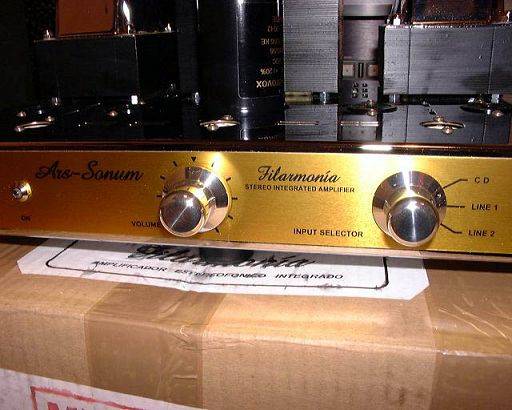
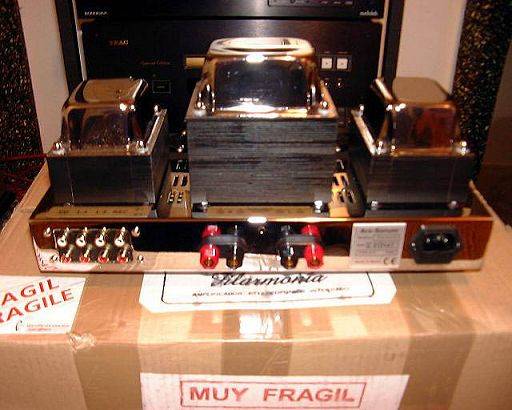
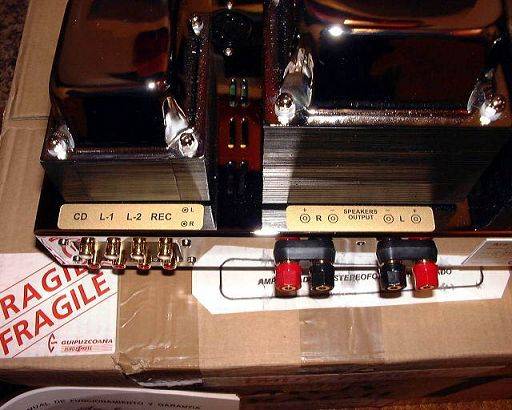
If we talk about the electronic parts in the amp it is necessary to talk about the output transformers, specially designed for this amplifier with the idea of getting the best possible frequency response in absence of global negative feedback. All the circuit is mounted on a PCB board very well designed (see the component layout on the PCB and the cable runs). Special care is placed in the earthing of the amp to minimize noises (star layout). The power supply has been also very well designed with 5 independent sections, 4 of them indepently stabilized for each channel and step, with the objective to have a lower level of interference between channels and each step. All the components used are of very good quality: Alps Blue Velvet volume pot, selected and matched metallic film resistors (0,5% tolerance) and Philips MKP polypropylene capacitors.

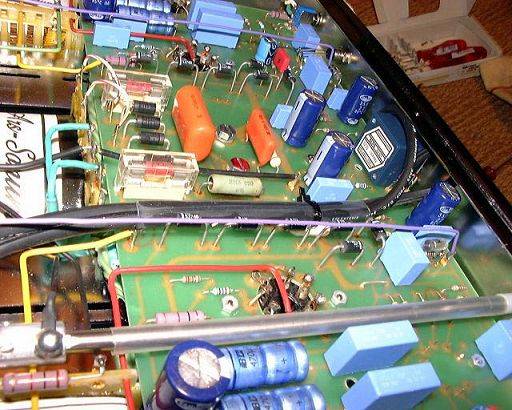
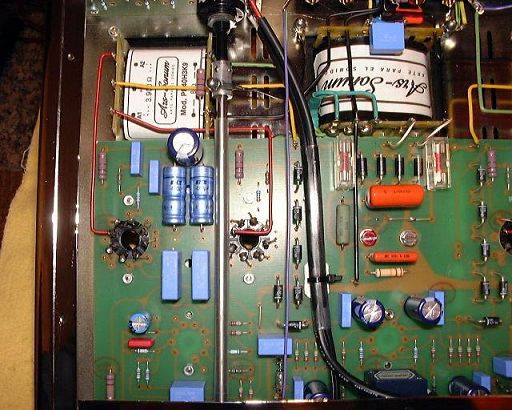
In every audition I do of a tube amplifier like the Filarmonia, two ideas comes always to my mind. First, why I need 300 watts if 30 watts are capable of doing what I'm listening? and second, Is it necessary to pay 6000 € for a tube amplifier if with an amplifier like that I can get this build and sound quality? The answer to the first question is that it is not necessary to used mega-watt amplifiers, if you match the amplifier with sensitive speakers (and I'm not talking about hyper efficient speakers) because 30 watts can give us a lot of music. The answer to the second question is, of course, no. It is not necessary to pay huge amounts of money to have a tube amplifier.
The equipment I have used in all these auditions has been: TEAC VRDS10SE CD player, Audiolab 8000DAX DAC, Monitor Audio Studio 20 SEC speakers, standard OFC speakers cables and Cardas 300B Microtwin as interconnets. If we focus on the auditions I have to say that this has been the amplifier that has stayed longer at home. I have spent many hours with it. But the most important thing of all the auditions with the Filarmonia is that I have learnt new things while listening to it. In the beginning, some of these new things surprised me but finaly I understood what the amp was trying to show me. It is in situations like this that I really enjoy listening new equipment. If we concentrate in the sound, I must say that the Filarmonia is an excellent amplifier. The first serious audition revealed many aspects that were confirmed in the following sessions. Very good punch, great bass extension and also excellent voices. After 1,30 hours of audition the sensations were very positive. Using my CD test disc I confirmed that dynamics were good and also transients, with a strong, extended and defined bass (Gloria Estefan-Por un beso). At the end of this audition, and while repeating some of the tracks in my test disc, I had the impression that the voices were "hidden" behind a "veil". I'm going to explain these words. As I said before the voices were very good but I felt that they sounded to me like if they were one step behind the rest of the instruments. I'm not saying that this was a problem of the amp, but remembering other amplifiers with the voices more "present", here they sounded less "in my face". I thougth that this was due to the amplifier configuration (it is not an ultralinear model), but Ricardo Hernandez kindly explained me what I was really listening to. I will explain it to you later.
In the second audition I continued with my test CD. Listening to Gloria Estefan (Por un Beso) I heard a great bass, with extension, good dynamic and also great voices. Claire Martin (Partners in Crime) also sounded very good. Stacey Kent (Shall we dance) showed a good voice, but with this track the sensation I have described before about voices not "present" was more noticeable. Kent's voice was very good, very real, but in a given moment when she projects her voice loud, I felt that I was missing something. In general terms the sound of the amp was very good. Maybe softer than other amplifiers I have tested but with enough power to party with it (the sound level pressure with the potentiometer at 12 o'clock was very, very important). I hadn't talked to Ricardo yet so I was thinking about this sensation and many question come to my mind: Is there any "veil"? Is it only a personal taste question? or, maybe, Is this the more natural amplifier I have listened to? We'll see.
In this audition I contiued listening to Gianmaria Testa (La traiettorie delle Mongolfiere) and Norah Jones (Nightindale). Jones' voice was more relaxed than normal, but still very good. This track, like others in her first record (Come away with me) are recordered with her voice "in the face" of the listener. Her voice comes from the center, in front of the group that plays with her. For my personal tastes, these presence is, sometimes, excessive. But with the Filarmonia, Norah Jones' voice was perfectly integrated with the rest of the group. The sensation of seeing Norah Jones jumping from the stage to the audience or seeing her singing ten meters in front of the group almost dissapeared. Uhmmm, that was interesting! The phrase "All the voices that spin around me..." of this song is usually painful for the ears and with the Filarmonia it sounded very good. The same thing happened with "Seven Years" song where the voice was less aggressive.
Again, in the third and fourth auditions a great bass was present. Testing the amp with other tracks I could listen, for example with Oscar Peterson Trio (The Trio Live from Chicago), how the drums sounded very well, very real. With Jane Monheit (Never, never land; Please be kind) the bass was ultra deep. In these two auditions the "veil" I talked about before, began to turn into someting very different. If, in the previous auditions, I thougth that this was a problem now I realised that in fact it was a virtue, because the amplifier was giving a great integration of all the instruments and voices. When some paragraphs before I talked about learning with this amp I meant this. I learnt to listen to my music in a different way, through the Filarmonia's touch. Some of the most aggressive tracks now sounded very coherent, less confused with all the group playing "together". If someting in the track had to be more present it was, but not unnecesarily. I really saw it with Stacey Kent's track. Maybe some of you may think that what was happened is that my mind and my ears were used to the filarmonia's sound. I supose that it is possible, but I prefer to think and to talk about what I was disvovering and what I was learning. Kent's voice was as clear as always but now it sounded more integrated between the piano and an excellent double-bass. All the good things of the song were still there but know they sounded as a real trio. Then I chosed "Mi buenos aires querido", by Baremboim-Mederos-Console. In this track the bandoneon at the begining could sound really hard with some amplifiers and now it sounded as powerful as always, but more relaxed and non aggressive. Sometimes I had the temptation of increase the volume to compensate the subjective sensation of softness, but, in fact, the sound level was already very high. Even if I turned up the volume to painful levels, the amp always sounded very good, with the excellet integration of all the instruments. Now, I was sure that the "veil" I described was the amplifier's signature. A great signature.
With Livingstone Taylor's version of Baker Street all these impressions were confirmed. Now I uderstood the amp! With the Filarmonia the music sounded played by a group, not by an individual or a group of instruments trying to play something together. Cassandra Wilson (Love is blindness) also sounded very well. The signature of the amplifier wasn't to hide anything, but to put all the things in the rigth place. I think that, in our days, this is very important, even more if we consider some equipment that is available around here.
In the following auditions I verified these impressions. The Filarmonia is a good choice for all the audiophiles that wish to buy its first tube amplifier, but I will recommend it to audiophiles with some experince with tube amps. It has a really great bass, it integrates all the instruments very well, voices sound great and there's no HUM at all (nothing, nothing, really impressive).
As I said before Ricardo Hernández, the man behind the Filarmonia, has been very kind with me during the auditions. It has given me all the explanations needed and has answered all my questions. I appreciatte very much his help and the love he has for his amplifier. He is doing it really well.
Ricardo Hernandez has made some comments to my thougths about his amplifier. According to Ricardo he tries "to free the musical reproduction of the excessive coloration that can be found in more conventional designs, based in concepts developed in the 1950s". I must say that he does it rigth. He also says that he tries to "design a basic circuit with low amounts of negative feedback in order to low the distorsion and increase the frequency response. These can only be achieved with a huge work in the design and build of the output transformers and an obssessive care of the power supply circuit". I believe that this two points are very important in the design of a tube amplifier. After seeing this amp I can say that the world is full of tube amplifiers but there aren't many Filarmonia.
Finally, Ricardo has sent this information about the different configurations he offers for his amp:
Filarmonia Triode:
From here my best wishes to Ricardo and a big thank you for his help.
In my opinion, as I said before, the Filarmonia is an excelent amplifier, very well made and that offers a very high sound quality to the audiophile. If you want to know more about it, specially about its specifications, you can read an article by Suso Ramallo and Juan José del Coso at http://www.lasalademaquinas.com/Filarmonia.pdf (it is written in spanish). Now you can add another tube amp to your wish list.